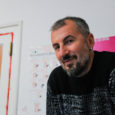Beginning in Belgrade and later sweeping Niš, Novi Sad and Kragujevac, protests that sparked in Serbia on July 7 are still ongoing, albeit on a smaller scale. However, especially in the first days, they were constantly turning from peaceful to violent, while the reasons for protesting have been piling up ever since.
What triggered people to take to the streets was the announcement of new measures aimed at tackling the spread of COVID-19, coupled with the reintroduction of a lockdown. Nevertheless, there were far more causes of dissent and these went well beyond the current situation, as demonstrated by the protests themselves.
Discord, violence, arrests, attacks on media professionals, all this is but a part of the events we witnessed in the first days of intense protesting. The motives behind various groups demonstrating seemed to have been different. The streets of Belgrade and other cities echoed with a plethora of slogans, from demands for government change to the now traditional chants pertaining to Kosovo and reminders of myths.
Serbian streets have been paraded by priests, groups displaying religious symbols, as well as individuals with leftist insignia. It would be daunting to find a common protest message, but all these actors do have something in common — discontent and anger.
Dejan Kožul has been present in the tear-gassed streets of Belgrade from day one, writing about new developments.
The onset of discontent
Serbia declared a state of emergency due to the coronavirus outbreak on March 15. The decision was only ratified by the parliament on April 29, but on May 6 — two days after president Aleksandar Vučić had set the election date for June 21 — the state of emergency was lifted.
On the day the government had declared the state of emergency, 48 people had tested positive for COVID-19. The number of new infections peaked on April 16, with 445 confirmed cases.
On the day the state of emergency was lifted, the number of people with COVID-19 in Serbia — according to the official reports — was at 9,791, with 114 additional cases confirmed.
Around this time, the government was reported to be hiding the real numbers. BIRN discovered that 632 patients died from COVID-19 in the period from March 19 to June 1 — 388 more than the official data for the same period.
And then it was as if the emergency had never happened in the first place.
According to BIRN’s investigation, the number of daily infections by the end of the previous week ranged from 300 to 340, which significantly exceeded the official record of 97 new cases.
The piece raised a further issue of trust in Serbia’s Crisis Headquarters and the data revealed to the public by the government structures, who in turn challenged and disparaged BIRN’s claims. In the end, the contested piece was forgotten.
After months of isolation, Serbia opened up, the lockdown was lifted, and what had been the most repressive set of measures in Europe was declared null and void. The government celebrated victory over the coronavirus.
Meanwhile, political parties embarked on an election campaign, this time without big public rallies.
And then it was as if the emergency had never happened in the first place. Crvena Zvezda and Partizan met in a national cup derby, with 20,000 people in attendance. Supporters were invited to the title winning celebration and nothing seemed to disrupt the pre-election harmony.
‘Election’ hotspot
Although election rallies were not recommended, some politicians tended to publicly sidestep this. Social media users had an opportunity to see a one-of-a-kind political spectacle when Trade and Tourism Minister and Deputy PM Rasim Ljajić dived into a crowd of supporters at an election rally held in Novi Pazar.
The city would go on to become an outbreak hotspot within a few days.
The official data reveals that the number of new cases plateaued by the elections, they did not exceed 100.
The election results are already well known: The ruling Serbian Progressive Party (SNS) won more than 60% of the votes, while only two more parties made it to the parliament — even though the election threshold had been lowered from 5% to 3% — the Socialist Party of Serbia, led by Slobodan Milošević’s heir Ivica Dačić, and the former water polo player Aleksandar Šapić’s SPAS.
The official data reveals that the number of new cases plateaued by the time of the elections; they did not exceed 100. However, on June 23 — two days after the poll — the picture began to change. The number of confirmed cases went up, reaching almost 400 a day before the president announced a return to draconian outbreak response measures.
In the meantime, Sandžak became a hotspot, with the first reports coming through social media. An Italian-like scenario played out in Novi Pazar, so PM Ana Brnabić and Health Minister Zlatibor Lončar decided to pay a visit to this fairly neglected region of Serbia.
Instead of expressing concern and taking concrete action, the two suggested that everything was under control. The scenes from Sandžak, showing people counting the dead and infected, contradicts them.
A game of numbers and measures ensued.
On July 2, president Vučić first announced that university students were to be evicted from their dorms, generating outrage and prompting the decision to be reviewed shortly. Students stay in their dorms, but it is unclear until when or whether it would be until all exams are over, this being one of their conditions.
At an extraordinary press conference held on July 7, Vučić revealed the plan to lock down Belgrade again, from 6 p.m. on Friday, July 10, until 6 a.m. on Monday, July 13.
“It would take a miracle for the lockdown not to be imposed,” Vučić told Belgraders. “If the numbers improve in the next two days — which I doubt — the decision won’t be implemented.”

After months of frustration building up, protesters took to the streets following President Vučić’s announcement of a return to lockdown. Restrictions had been eased ahead of elections. Photo: Dejan Kožul.
The discontent stacking up since March spilled over into the streets following his statement.
On that day, 13 people died from COVID-19 across Serbia. It was the highest daily death toll so far.
Day one (July 7)
People began gathering in front of the Serbian parliament one hour after Vučić’s address. Around 7 p.m., some 100 people were there, but the number kept growing. It was comparatively peaceful in the beginning, with only a passing shout, slogan or whistle heard from time to time. However, the crowd was growing bigger and bigger.
At one point, the protest was taken over by a group calling themselves “Narodna patrola,” (National Patrol) known to the public for their anti-immigrant stance. The group is a part of the “Nema predaje Kosova i Metohije” (Don’t Surrender Kosovo and Metohija) initiative, led by Damjan Knežević.

Known for their nationalist and anti-migrant stance, “Narodna patrola” (National Patrol) tried to take over the protests. Photo: Dejan Kožul.
They were the ones that spearheaded the attack on the parliament building, calling forth a relatively quick and tense response from the police that involved tear gas and the use of force.
According to a police report, at least 43 police officers and 17 protesters were injured that night, while 24 people were arrested. The police denied the allegations of “using excessive force,” but a substantial amount of on-site footage shared on social media around this time spoke to the contrary.
The A11 initiative, an NGO protecting vulnerable and marginalized people, said that the Interior Ministry officials intervening in the protest organized in Belgrade on the evening of July 7 and the morning of July 2020 used excessive force in dozens of cases. A11 invited the survivors to reach out to them.
It was clear that the protests would continue the next day.
Day two (July 8)
The footage showing police brutality drew more people to the streets than the day before. Part of the credit goes to the Alliance for Serbia leaders (Dragan Đilas, Vuk Jeremić, Boško Obradović, Janko Veselinović), who held a rally in the Philosophy Faculty square — over the previous days it had served as the gathering place for protesting students — and then led the crowd toward the Serbian parliament.
And some new, young, angry people were gathered in front of the parliament. They were accompanied by a large number of unknown lads wearing black T-shirts and caps, Krik reports.
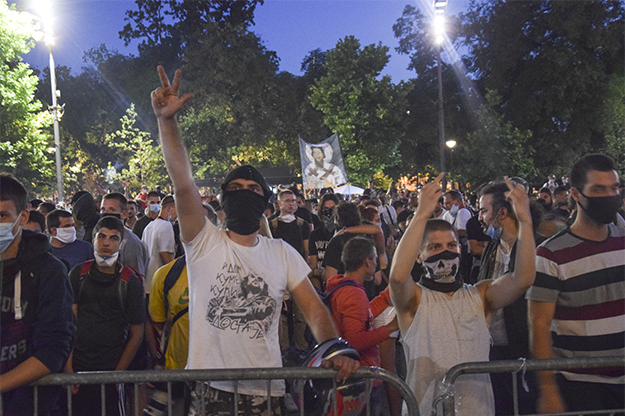
Some new, young, angry people with old messages leading the protests during the riots in Belgrade. Photo: Dejan Kožul.
Protesters attempted to break into the parliament building. The police tear-gassed them after a group of protesters had breached their barricades and headed toward them. The crowd dispersed from the square, but they were chased across the city.
Within an hour, the police tear-gassed the crowd 10 times and violent scenes harking back to the previous night were repeated. A Beta news agency journalist was attacked as well, despite showing his journalist ID.

In the first days, the crowd was tear-gassed dozens of times. Photo: Dejan Kožul.
The police also reportedly assaulted two journalists from Nova; Milica Božinović was hit on the fingers with a baton, dropping her phone, while Nataša Latković had her journalist ID thrown away by the police. Both of them had shown their IDs to police officers.
The same night, head of the police Vladimir Rebić announced that 118 police officers had been injured over the past two days of protests. They were now being treated in health institutions across Serbia, while 153 people had been prosecuted.
Rebić commented on the accusations of “infiltrated groups,” pointing out how numerous reports of protesters being infiltrated by security agency officials in order to cause disturbance was false.
“This is absolutely not true,” Rebić held. “The events taking place in the last two days constitute a serious and orchestrated attack on the police.”
In addition, he denied that the police used rubber bullets or water cannons on the protesters.
“All these lies are aimed at tarnishing the Interior Ministry’s reputation, which serves as a justification for the attacks on police forces and mayhem in the streets,” Rebić said.
Novi Sad, Kragujevac and Niš citizens joined the protests the same night. In Novi Sad, protesters charged at City Hall and the Public Broadcasting Service of Vojvodina buildings, also attacking the RTS television crew. One of their cameras ended up being broken, while cameraman Lazar Vukadinović suffered an arm injury.
According to bystanders, the police physically attacked a cyclist at the protests in Novi Sad, one of the policemen "kicking him as he was lying on the ground defenseless".
Similarly, in Niš, another RTS camera operator was hit on the head.
Some protesters began distancing themselves from violence after the violent scenes from Novi Sad. However, the arrests continued. Miran Pogačar, an activist from the “Za krov nad glavom” (A Roof Over Your Head) joint action, was apprehended the same night.
At the protests in Novi Sad, the police — according to bystanders — physically attacked a cyclist, with one of the policemen “kicking him as he was lying on the ground defenseless.”
The “Autizam promena za 180” (Autism changes for 180) association called for the head of the police to investigate the case and punish the perpetrators.
“Unfortunately, [the cyclist] was a young person with autism,” association president Dario Rosi wrote in a letter. “We suppose that the facts and details of this event are already known to you. If not, we will gladly send you the information we have: Footage, name of the injured boy, the part of Novi Sad he lives in, name of the school he attends, name and surname of the inspector of the Interior Ministry of Novi Sad for whom there are reasonable grounds to believe that he applied excessive force.”
Violence was a protest leitmotif in Kragujevac as well, where the police station windows were broken. In this case, the police force did not react.
Day three (July 9)
The third day of protests had a specific dynamic to it. The previous day, a number of non-violent protesters from Novi Sad had sat on the ground, refusing to leave the public space in a gesture of defiance against the government and those keen on violence alike.
Protesters in Belgrade pushed forward this idea on day three. Or at least tried to do so.
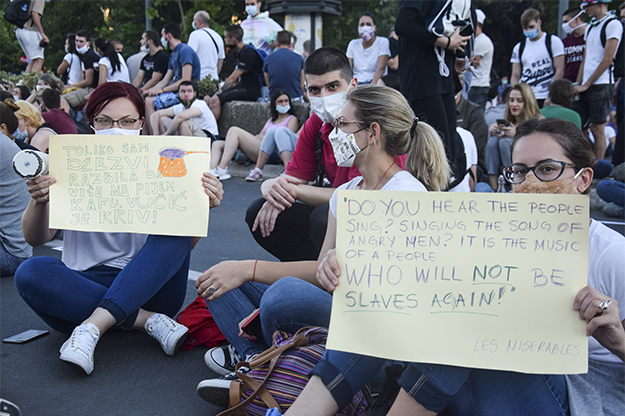
A number of protesters in Belgrade tried to invite others to protest peacefully, albeit with partial success. Photo: Dejan Kožul.
“Don’t fall for it, sit down” was the guiding principle of the protests held that day across Serbia. Protesting factions called for all to sit down, responding to each sign of violence with whistles of disapproval and kicking out the troublemakers.
No police cordons were seen in front of the Serbian parliament that day, even though they did wait behind it. However, everything went peacefully and there was no need for them to respond.
Still, that day was only a brief respite.
Day four (July 10)
It was clear from the very first minutes of the fourth day that the scenes seen on the first and second day of protests were set to be replayed.
Early in the evening, war veterans organizations’ members with clearly displayed insignia were seen huddling in the parliament square. They were joined by Damjan Knežević, who had been apprehended following the first day of protesting, but soon released.
These protesters’ goal was to suggest that sitting in protest was not what they wanted. At first, they seemed to be against violence, yet things quickly and quite easily got out of hand. With caps and face masks often covering everything except eyes, the youth in black T-shirts took control of the space in front of the Serbian parliament, engaging in a game with the police. Shortly, the latter formed a barrier between the protesters and the parliament building.
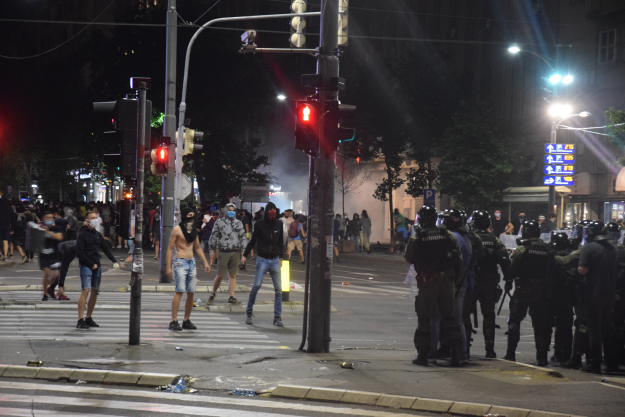
Violence continued on the fourth day, with masked young men at the forefront facing the police. Photo: Dejan Kožul.
Armed with pyrotechnics and stones, the unrelenting protesters taunted the police. Now they had an excuse to respond.
This day will be remembered for a large number of attacks on journalist crews, perpetrated both by the protesters and the police.
According to the Independent Journalists’ Association of Serbia, more than 20 attacks were carried out against journalist crews in the four days of protesting.
Following the fourth day, head of the police Vladimir Rebić said that 71 people had been arrested, while 130 injured police officers had had to seek medical help.
Day five (July 11)
On the fifth day, the protests decreased in intensity and there were no violent scenes. However, according to Miran Pogačar, a Novi Sad-based activist from “Za krov nad glavom” — who joined the protesters in Novi Sad — more than 50 people were arrested, including three activists from their organization.
“Igor Šljapić was arrested on Saturday evening before being sentenced to 30 days imprisonment, because he protested with a banner saying ‘Stop violence,’” the organization claims, adding that an Institute of Social Sciences fellow and Sociological Association of Serbia member Vladimir Mentus was also arrested, even though he did not take part in any action directed against the police.
Mario Marković was arrested while he was delivering food on a bicycle, despite not having partaken in the protests at all.
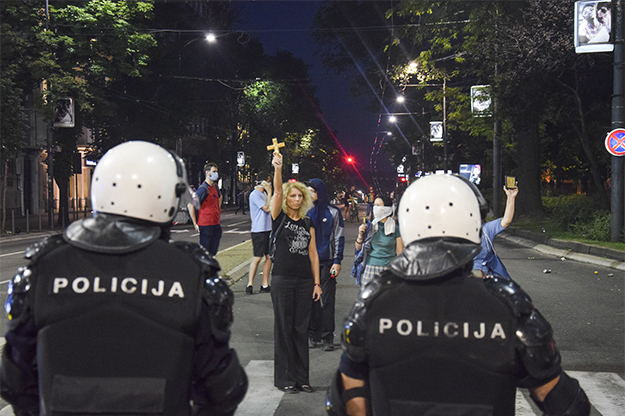
Confusion, disunity, violence, extreme right, left-wingers, young hooligans, politicians in the streets — this is just part of the story about the protests that began in Serbia in early July. Photo: Dejan Kožul.
They were all sentenced to a 30 day prison sentence without their lawyers present.
Arrests and quick trials have led to new protests, now organized in front of the prison, prosecutor’s office and government. Protesters are demanding the release of convicts they call political prisoners. Moreover, they are urging the authorities to take legal action against police officers responsible for violence.
At the same time, Belgrade-based human rights NGO A11 is pressing four criminal charges against 23 police officers due to an excessive use of force.
The police have announced that some attackers who targeted journalists have been arrested.
The epilogue
The protests are now into their third week and are organized every day. However, the number of participants have become smaller, since most of them are now focused on the struggle for the release of prisoners.
The CRTA monitoring mission along with the A11 Economic and Social Rights Initiative proposed a motion to the Ombudsperson, asking the office to issue a public recommendation for the dismissal of Vladimir Rebić as the head of the police, due to his alleged responsibility for an illegal use of force in the protests.
Having been contacted to identify the cases of excessive force used by the police, Ombudsperson Zoran Pašalić announced that they had concluded that there was no “systematic use of excessive force,” but rather individual cases only.
“Excessive use of force can turn into police brutality. We have identified eight cases of brutality, accordingly initiating legal proceedings,” the Ombudsperson told the press.
The number of COVID-19 cases in Serbia is still growing. However, as the virus spreads, so does dissatisfaction. Meanwhile, the country enters a period of economic crisis.
Feature image: Dejan Kožul.








